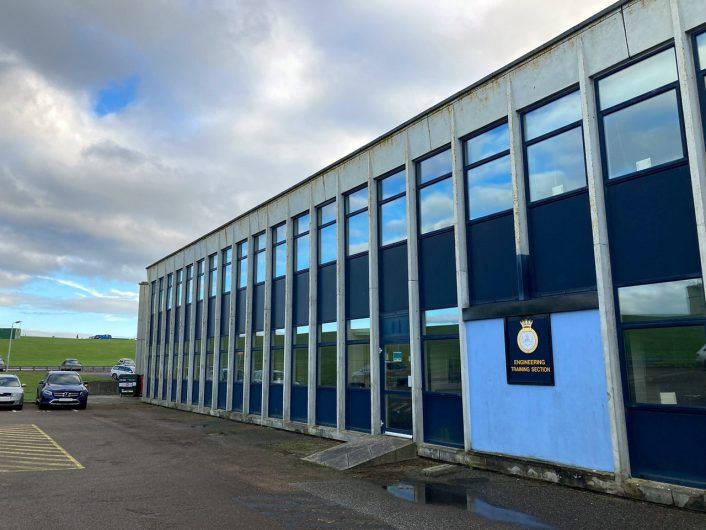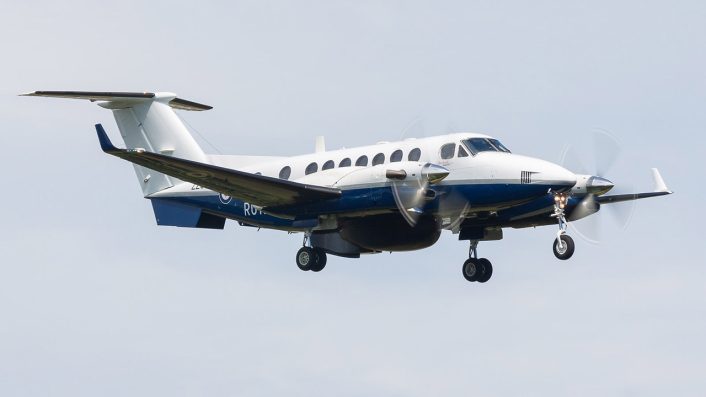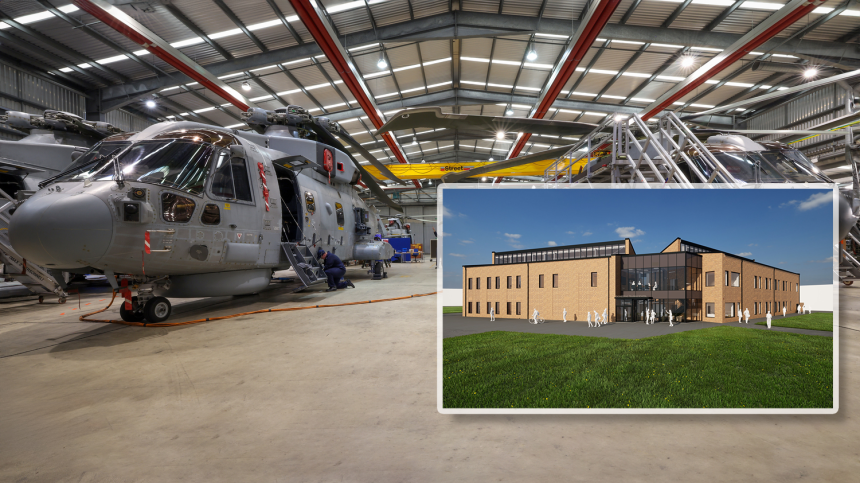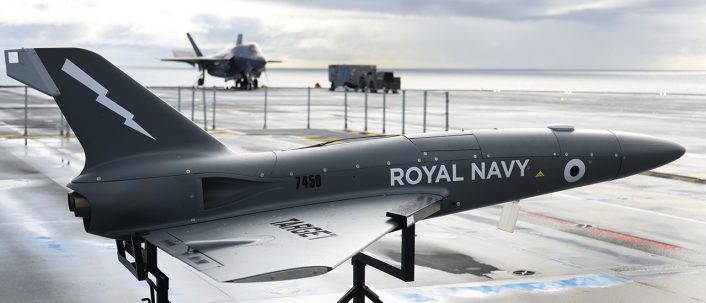A new hangar and air engineering training school will be constructed at the base, home of the Royal Navy’s Merlin HM2 helicopters, alongside refurbishment of existing facilities.
In the first phase of a £100 million redevelopment project, RNAS Culdrose will receive a brand new air engineering training school to facilitate the instruction of future generations of Fleet Air Arm aircraft maintainers. 820 Naval Air Squadron, one of the base’s two frontline Merlin HM2 units, will see an extensive overhaul of their existing facilities, some of which have been in place for many decades. The unit will also receive a new hangar.
Culdrose is home to the Fleet Air Arm’s entire force of Merlin HM2 helicopters, which provide the Royal Navy with anti-submarine warfare, search and rescue, airborne early warning and general utility capabilities. The base also hosts 700X Naval Air Squadron, a dedicated unit for maritime unmanned air systems. 700X NAS operates a varied range of UAVs for both operational use and trials.

Captain Stuart Irwin is the current Commanding Officer of RNAS Culdrose, and commented on the project: “This project marks the start of an exciting regeneration and investment in RNAS Culdrose with new, modern facilities. The Engineering Training School is at the heart of our operations to maintain the Merlin helicopter fleet. Our young people, many of whom are just at the start of their naval careers, will learn how to maintain aircraft in a high-tech and modern teaching environment.
“The refurbishment of aircraft hangars and buildings at 820 Naval Air Squadron is another significant investment. It will provide us with more suitable and sustainable places to operate Merlin Helicopter Force now, and into the future.”
The announcement of this investment comes following another large project at the base – the replacement of all nine miles of security fencing around the site. The existing fencing had served beyond its useful life and regularly had to be repaired and strengthened after collapses. Construction work for this fence upgrade began in January 2024 and concluded in October 2024.
10 months & 9 miles later, the entire fence around Culdrose has been replaced. @RoyalNavy Captain Stuart Irwin thanks Jason Thorpe of Littlewood Fencing, with Neil Howe, head of infrastructure & @VIVODefence project manager Gareth Payne & regional lead Terry Grimes @mod_dio pic.twitter.com/InqSpsqfWB
— RNAS Culdrose (@RNASCuldrose) October 18, 2024
The new fence incorporates high visibility red and white panels to mark the location of the base’s runways, as well as sections composed of a different type of mesh which reduces interference with radar.
Towards the end of the project, RNAS Culdrose were able to place Hawk T1 XX280 back in its earmarked position as a display airframe or ‘gate guard’ in a prominent corner of the station. The aircraft has been stored for future display use at the base since the disbandment of 736 Naval Air Squadron in 2022. It was briefly placed on display in 2023, but could not remain in position while the fence was being replaced as it would obstruct construction work.
Hawk T1s of 736 Naval Air Squadron operated from the base in an aggressor role, working in conjunction with Falcon 20s from Draken Europe (formerly Cobham) to play ‘Red Air’ in exercises with NATO forces across the south west UK region. The squadron stood down in 2022 after nine years in commission (the Hawks had previously been operated at Culdrose by the Fleet Requirements and Direction Unit or FRADU since 1995).
Yesterday we moved our last veteran Hawk jet (they were retired in 2022) back to its position near the roundabout to the The Lizard, where it will be installed on permanent display as an RNAS Culdrose gate guardian @RoyalNavy
Music https://t.co/nkznBOaYZ6 code: UY7CFVPAPXXS9SOX pic.twitter.com/WqT709Iju3
— RNAS Culdrose (@RNASCuldrose) September 12, 2024
No direct replacement was fielded for 736 NAS’ Hawk T1s, though Draken continues to provide their Falcon 20s for exercises. Some Royal Navy Banshee target drones, now operated by 700X NAS, which could fulfil at least some roles previously covered by the Hawks, notably though have been seen with lightning bolt tail markings very similar to the emblem used by 736 NAS.

The extended contract with service provider Ascent Flight Training will additionally include upgraded electronic training equipment that will be able to better reflect new technologies that are entering service with the Royal Navy and Royal Air Force as well as the improved capabilities of the Avenger aircraft. This ranges from specific mission training equipment through to basic computing equipment. Following a recent upgrade of computer monitors used in the squadron’s facilities, surplus monitors were donated to local schools.
In 2026, the existing contract will transform into the new Future ISTAR and Rear Crew Training System (FIRCTS) program. This program, split between RNAS Culdrose and RAF Cranwell, will form the training pipeline for mission crews not only for Fleet Air Arm Merlin and Wildcat helicopters but also for Royal Air Force RC-135, Poseidon, Shadow, Wedgetail and Protector aircraft.
RNAS Culdrose
Royal Naval Air Station Culdrose, or RNAS Culdrose, is one of the Royal Navy’s two Fleet Air Arm bases, and is located near Helston, Cornwall, approximately eight miles from mainland Britain’s most southerly point. Construction began in 1942 as a wartime airfield, though was not completed until 1947. This makes RNAS Culdrose the most recent military airfield to be constructed in the UK.
The base is home to three squadrons of Merlin HM2s (814 NAS, 820 NAS, 824 NAS), one squadron of Avenger T1 (750 NAS) and one UAV unit (700X NAS). Also at the base is 1700 Naval Air Squadron, an aviation, engineering and logistics squadron that provides support to Royal Navy operations worldwide. Until 2016, Culdrose was well known as the home of 771 Naval Air Squadron, a search and rescue unit with many famous rescues to their name. A number of their former Sea King HU5 aircraft now serve with the Ukrainian armed forces.
Need a different view from isolation? Here is something you’d never normally see– the view from inside an iconic @RoyalNavy Sea Harrier, used here for training aircraft handlers at RNAS Culdrose. Using real aircraft makes training as realistic as possible pic.twitter.com/NYAzvT6HDM
— RNAS Culdrose (@RNASCuldrose) April 16, 2020
The Royal Naval School of Flight Deck Operations (SFDO) uses several sites on the airfield, including a replica aircraft carrier deck, to instruct Fleet Air Arm aircraft handlers on safe ground handling procedures. SFDO has a selection of aircraft to use as part of this training, alongside four F-35 replica ground training aids. Until recent years, the unit operated a number of Sea Harrier FA2 airframes in running condition, able to taxi under their own power to add an ultra-realistic carrier deck experience for crews undergoing instruction.










